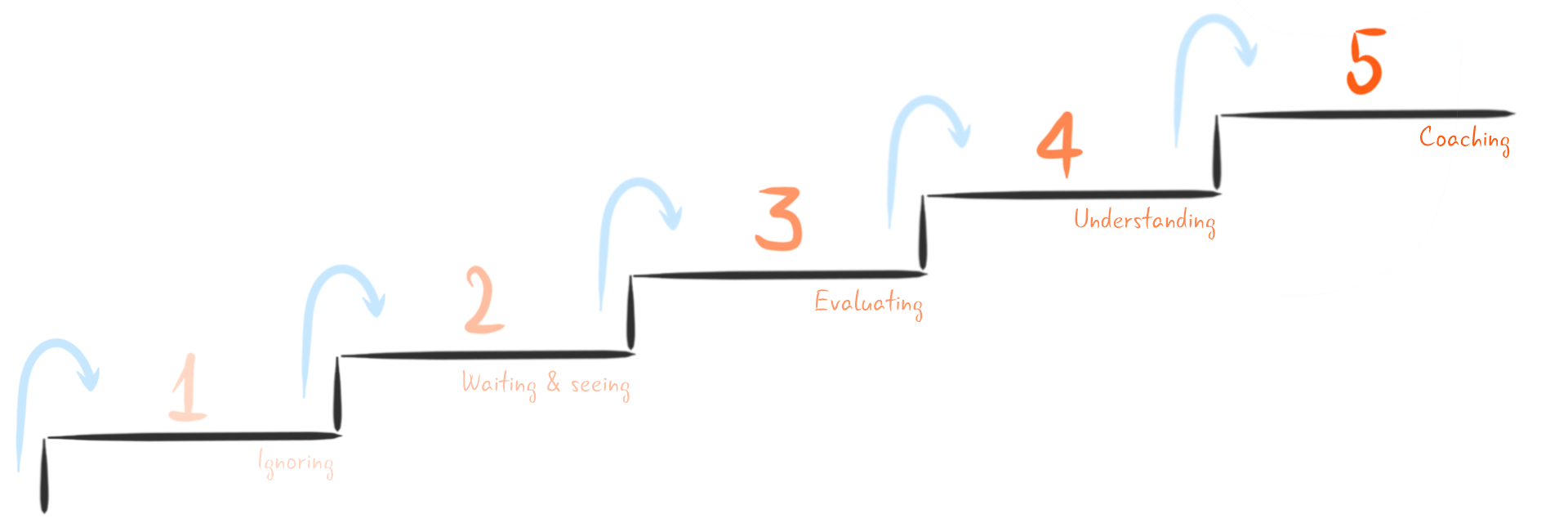5 levels of listening
Are you listening or just waiting to talk yourself?
Two-way communication is the key to success or failure when it comes to Innovation. The rare art of listening as a skill to act rather than react is proving to be a key competence. It requires active listening when it comes to developing complex technologies, new disruptive business models and collaborative strategies with start-ups, corporates, partners and customers in the digital age.
Genuine interest and active listening are also like that extra something when it comes to building sustainable relationships and creating a trusting environment in which innovation can take place.
The better and more trusting relationships amongst colleagues are, the easier and more effortless communication and cooperation will be. Showing empathy while remaining authentic is an important factor when it comes to good teamwork or leadership. If communication is not performed properly, motivation and thus performance decreases. Both leaders and managers, too, need to acknowledge empathy to be a soft skill that is a crucial factor to success. It should be perceived as and acquired like basic education just like algebra and spelling.
Empathy can be learned
The good news is that empathy can be learned, as can active listening as it´s communicative implementation. Carl R. Rogers (1912-1987), an American psychologist and psychotherapist famous for developing client-centered talk therapy and nominated for the Nobel Peace Prize in 1987, first described the idea of active listening.
Active listening builds and strengthens relationships. Since a good relationship is an essential basis for successful cooperation, it makes perfect sense to practise it. Unfortunately, we fall into so-called listening traps time and again. In science and practice, we speak of about three to ten levels or types of listening. ROOM FOR IDEAS find Bob Thompson’s five “levels of listening” most useful, as they are practical and clearly understandable.
Level 1
"Ignore"
Who has not experienced that the person you are talking to has said nothing but “yes”, “aha”, “hm” or “good” while you were talking about an event? Or that managers who are driven by time and performance pressure want to have a positive influence on their employees and listen, but at the same time look at their laptop? This behaviour permanently damages relationships with their colleagues. In level 1, this is equated with “not listening” or “ignoring”.
Incongruence damages the Relationship
The positive verbal message does not match the disinterested inner attitude and thus negatively perceived non-verbal message. The talking partner senses this incongruence immediately and loses trust in the leader and the leader loses credibility.
Level 2
"Are you really listening, or just waiting until you can talk yourself?"
Do you happen to catch yourself listening at level 2? Well, “Waiting to talk yourself” is only done by others… isn’t it? In this stage, we wait until the other person pauses for breath or even gives us a cue to which we have a lot to say and then we burst out with our take on things. We might think we are actively listening, but we are not actually. Our focus is on what we want to communicate rather than it being on the other person. Having regular conversations with a Level-2-Listener quickly leads to losing interest in sharing our own thoughts and experiences because we do not feel understood.
Level 3
The most common Way of Listening
“Listening to evaluate” is what people do most often. Especially in meetings and discussions, but also in everyday conversations, we tend to give our opinion without being asked for it. In some cases and professions, this may be appropriate and common practice ‒ being a lawyer in court, for example. However, this kind of objection or approbation of what we hear does not necessarily lead us to really understand what our talking partner actually wants to get across. We don’t get to know their motives through a “No, I don’t think so” or “Yes, that’s right, you’re right”. Remaining at this level of listening cannot lead to real relationship building.
Attention!
Remember, especially in the ideation Phase it is important neither to judge nor to criticize. in this sensitive phase of the innovation process, disturbances reduce the capacity for divergent thinking and make Ideation less effective.
Level 4
Strengthening the Relationship
“Listening to understand” means that we try to see the other person’s world through their eyes, follow their thoughts and empathize with their feelings. In short, we listen and put ourselves in his shoes. That is empathy. It is not a conversation technique, but rather an inner attitude that is characterized by genuine interest in the other person as well as in their perspective and emotional world. Possibilities to actively support this verbally are
- Eye contact
- Attentive body posture
- Asking open questions: When? Where? How? Why? What?
Wouldn’t it be exciting to consciously focus on level 4 during the next conversation?
Level 5
Coaching
Level 5 is usually reserved for coaching, as the highest dimension of understanding can arise through questioning and discussion techniques – namely, that our counterpart suddenly understands themself better and thus comes up with their own new ideas and solutions.
Have you often found yourself at level 1 to 3? Never mind. Empathy can be learned and practised.
